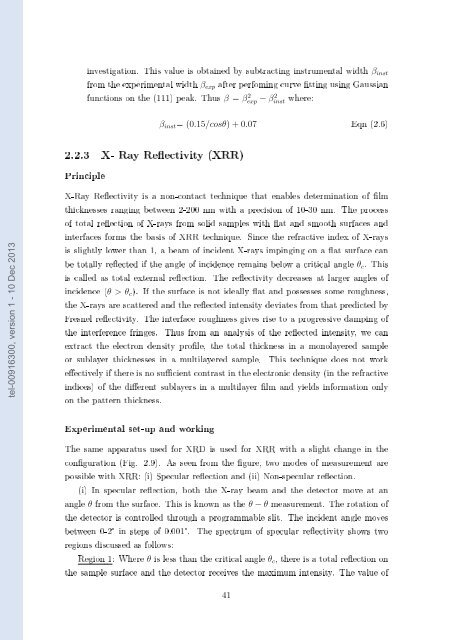Films minces à base de Si nanostructuré pour des cellules ...
Films minces à base de Si nanostructuré pour des cellules ...
Films minces à base de Si nanostructuré pour des cellules ...
Create successful ePaper yourself
Turn your PDF publications into a flip-book with our unique Google optimized e-Paper software.
investigation. This value is obtained by subtracting instrumental width β inst<br />
from the experimental width β exp after perfoming curve tting using Gaussian<br />
functions on the (111) peak. Thus β = β 2 exp − β 2 inst where:<br />
β inst = (0.15/cosθ) + 0.07 Eqn (2.6)<br />
2.2.3 X- Ray Reectivity (XRR)<br />
Principle<br />
tel-00916300, version 1 - 10 Dec 2013<br />
X-Ray Reectivity is a non-contact technique that enables <strong>de</strong>termination of lm<br />
thicknesses ranging between 2-200 nm with a precision of 10-30 nm. The process<br />
of total reection of X-rays from solid samples with at and smooth surfaces and<br />
interfaces forms the basis of XRR technique. <strong>Si</strong>nce the refractive in<strong>de</strong>x of X-rays<br />
is slightly lower than 1, a beam of inci<strong>de</strong>nt X-rays impinging on a at surface can<br />
be totally reected if the angle of inci<strong>de</strong>nce remains below a critical angle θ c . This<br />
is called as total external reection. The reectivity <strong>de</strong>creases at larger angles of<br />
inci<strong>de</strong>nce (θ > θ c ). If the surface is not i<strong>de</strong>ally at and possesses some roughness,<br />
the X-rays are scattered and the reected intensity <strong>de</strong>viates from that predicted by<br />
Fresnel reectivity. The interface roughness gives rise to a progressive damping of<br />
the interference fringes. Thus from an analysis of the reected intensity, we can<br />
extract the electron <strong>de</strong>nsity prole, the total thickness in a monolayered sample<br />
or sublayer thicknesses in a multilayered sample. This technique does not work<br />
eectively if there is no sucient contrast in the electronic <strong>de</strong>nsity (in the refractive<br />
indices) of the dierent sublayers in a multilayer lm and yields information only<br />
on the pattern thickness.<br />
Experimental set-up and working<br />
The same apparatus used for XRD is used for XRR with a slight change in the<br />
conguration (Fig. 2.9). As seen from the gure, two mo<strong>de</strong>s of measurement are<br />
possible with XRR: (i) Specular reection and (ii) Non-specular reection.<br />
(i) In specular reection, both the X-ray beam and the <strong>de</strong>tector move at an<br />
angle θ from the surface. This is known as the θ − θ measurement. The rotation of<br />
the <strong>de</strong>tector is controlled through a programmable slit. The inci<strong>de</strong>nt angle moves<br />
between 0-2° in steps of 0.001°. The spectrum of specular reectivity shows two<br />
regions discussed as follows:<br />
Region 1: Where θ is less than the critical angle θ c , there is a total reection on<br />
the sample surface and the <strong>de</strong>tector receives the maximum intensity. The value of<br />
41
















